How Much Of The Unobservable Universe Will We Someday Be Able To See?

As more time passes since the Big Bang, more of the Universe comes into view. But how much?
Even though it’s been billions of years since the Big Bang, there’s a cosmic limit to how far we can observe the objects that occupy our Universe. The Universe has been expanding all this time, but that expansion rate is both finite and well-measured. If we were to calculate how far a photon emitted at the instant the Big Bang occurred could have traveled by today, we come up with the upper limit to how far we can see in any direction: 46 billion light-years.
That’s the size of our observable Universe, which contains an estimated two trillion galaxies in various stages of evolutionary development. But beyond that, there ought to be much more Universe beyond the limits of what we can presently see: the unobservable Universe. Thanks to our best measurements of the part we can see, we’re finally figuring out what lies beyond, and how much of it we’ll someday be able to perceive and explore.
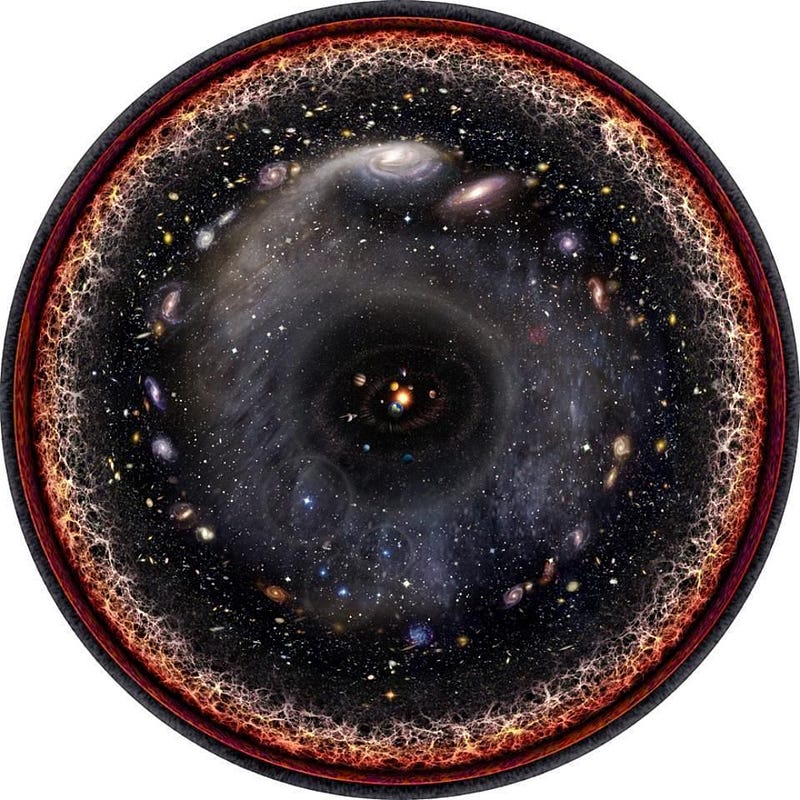
The Big Bang tells us that at some point in the distant past, the Universe was hotter, denser, and expanding much more rapidly than it is today. The stars and galaxies we see throughout the Universe in all directions only exist as they do because the Universe has expanded and cooled, allowing gravitation to pull matter into clumps. Over billions of years, gravitational growth has fueled generations of stars and the formation of galaxies, leading to the Universe we see today.
Everywhere we look, in all directions, we see a Universe that tells us the same cosmic story. But part of that story is the fact that the farther away we look, the farther we’re looking back in time. The Universe hasn’t been around, forming stars and growing galaxies, forever. According to the Big Bang and the observations that support it, the Universe had a beginning.
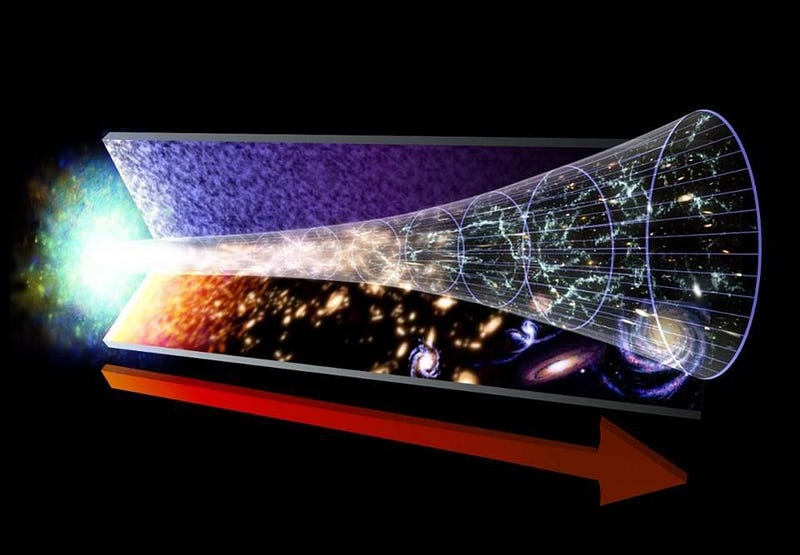
In the early stages after the Big Bang, the Universe was filled with a variety of ingredients, and it began with an incredibly rapid initial expansion rate. These two factors — the initial expansion rate and the gravitational effects of everything in the Universe — are the two head-to-head players in the ultimate cosmic race.
On the one hand, the expansion works to push everything apart, stretching the fabric of space and driving the galaxies and the large-scale structure of the Universe apart. But on the other hand, gravitation attracts all forms of matter and energy, working to pull the Universe back together. Normal matter, dark matter, dark energy, radiation, neutrinos, black holes, gravitational waves and more all play a role in the expanding Universe.

The expansion rate began large, but has been decreasing as the Universe expands. There’s a simple reason for this: as the Universe expands, its volume increases, and therefore the energy density goes down. As the density drops, so does the expansion rate. Light that was once too far away from us to be seen can now catch up to us.
This fact carries with it a huge implication for the Universe: over time, galaxies that were once too distant to be revealed to us will spontaneously come into view. It may have been 13.8 billion years since the Big Bang occurred, but with the expansion of the Universe, there are objects as far away as 46.1 billion light-years whose light is just reaching us.
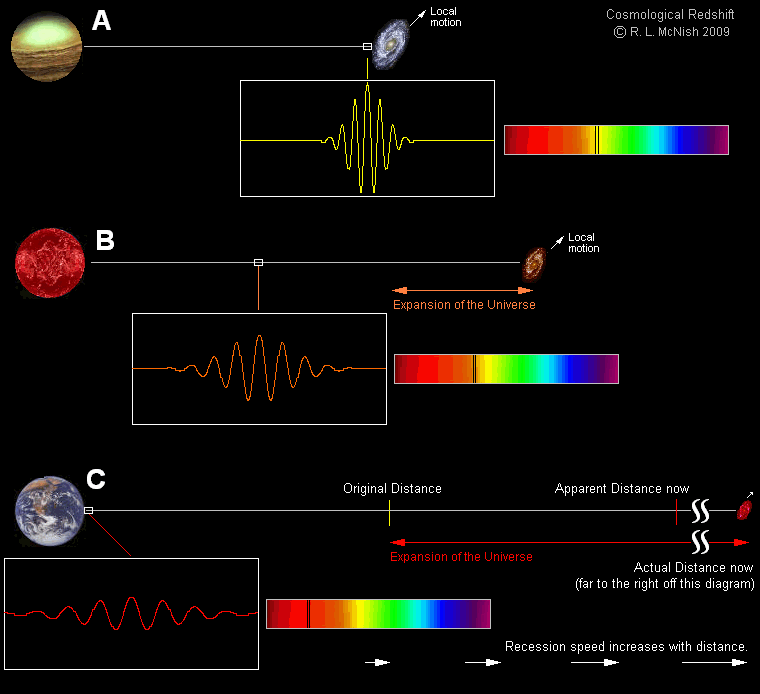
All told, if we were to add up all the galaxies that exist within this volume of space, we’d find there are a whopping two trillion of them within our observable Universe. As enormous as this number is, it’s still finite, and our observations don’t reveal an edge in space in any direction we look.
The amount of time that’s passed since the Big Bang, the speed of light, and the ingredients in our Universe determine the limit of what’s observable. Any farther than that, and even something moving at the speed of light since the moment of the hot Big Bang will not have had sufficient time to reach us.
But all of this will change in time. As the years and aeons tick by, light that was unable to reach us will finally catch up to our eyes, revealing more of the Universe than we’ve ever seen before.
You might think that if we waited for an arbitrarily long amount of time, we’d be able to see an arbitrarily far distance, and that there would be no limit to how much of the Universe would become visible.
But in a Universe with dark energy, that simply isn’t the case. As the Universe ages, the expansion rate doesn’t drop to lower and lower values, approaching zero. Instead, there remains a finite and important amount of energy intrinsic to the fabric of space itself. As time goes on in a Universe with dark energy, the more distant objects will appear to recede from our perspective faster and faster. Although there’s still more Universe out there to discover, there’s a limit to how much of it will ever become observable to us.
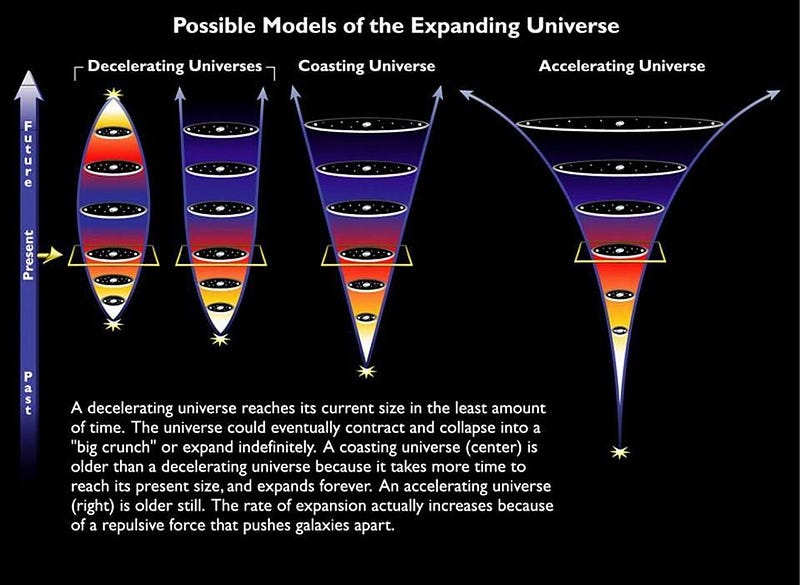
Based on the expansion rate, the amount of dark energy we have, and the present cosmological parameters of the Universe, we can calculate what we call the future visibility limit: the maximum distance we’ll ever be able to observe. Right now, in a 13.8 billion year old Universe, our current visibility limit is 46 billion light-years. Our future visibility limit is approximately 33% greater: 61 billion light-years. There are galaxies out there, right now, whose light is on the way to our eyes, but has not had the opportunity to reach us yet.
If we were to add up all the galaxies in the parts of the Universe that we’ll someday see but cannot yet access today, we might be shocked to learn that there are more yet-to-be-revealed galaxies than there are galaxies in the visible Universe. There are an additional 2.7 trillion galaxies waiting to show us their light, on top of the 2 trillion we can already access.

Compared to what the future holds for us, we’re presently only seeing 43% of the galaxies that we’ll someday be able to observe. Beyond our observable Universe lies the unobservable Universe, which ought to look just like the part we can see. The way we know that is through observations of the cosmic microwave background and the large-scale structure of the Universe.
If the Universe were finite in size, had an edge to it, or its properties began to change as we looked to greater distances, our measurements of these phenomena would reveal it. The observed spatial flatness of the Universe tells us that it is neither positively nor negatively curved to a precision of 99.6%, meaning that if it curves back on itself, the unobservable Universe is at least 250 times as large as the presently visible part.

We will never be able to see anything close to those extraordinary distances. The future visibility limit will take us to distances that are presently 61 billion light-years away, but no farther. It will reveal slightly more than twice the volume of the Universe we can observe today. The unobservable Universe, on the other hand, must be at least 23 trillion light years in diameter, and contain a volume of space that’s over 15 million times as large as the volume we can observe.

At the same time that we ponder the Universe beyond our observational limits, however, it’s worth remembering how little of that Universe we can actually access or visit. All that we’re looking forward to viewing is based on light that was already emitted many billions of years ago: close to the Big Bang in time. As it stands today, even if we left right now at the speed of light, we wouldn’t be able to reach nearly all of the galaxies throughout space.
Dark energy is causing the Universe to not only expand, but for distant galaxies to speed up in their apparent recession from us. Although there are a total of 4.7 trillion galaxies that we will someday be able to observe out to a distance of 61 billion light-years, the limit of what we can reach today is much more modest.
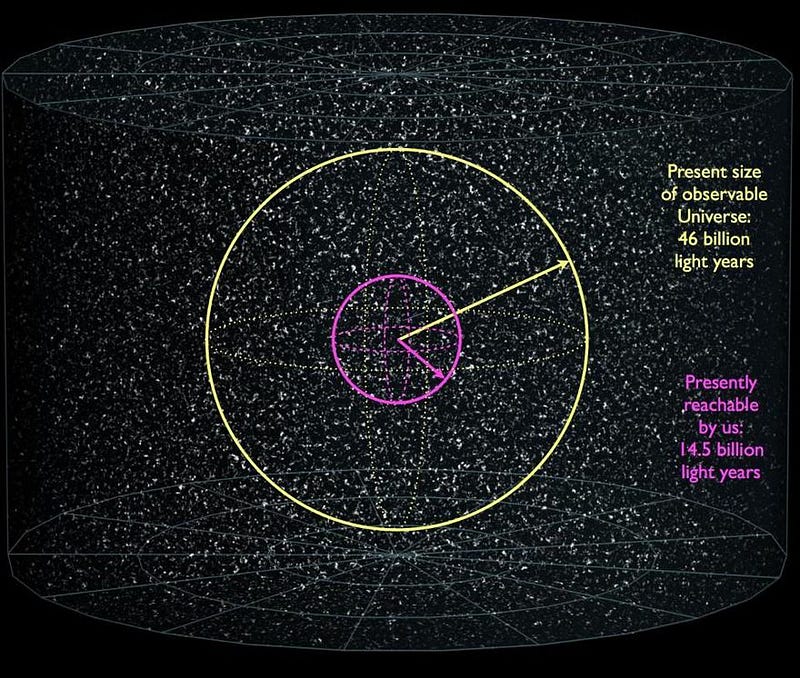
Only those galaxies within approximately 15 billion light-years, or a quarter of the radius at the future visibility limit, can be reached today, which equates to about 66 billion galaxies only. This is only 1.4% of the total number of galaxies that will ever become visible to us. In other words, in the future, we will have a total of 4.7 trillion galaxies to view. Most of them will only ever appear to us as they were in the very distant past, and most of them will never get to see us as we are today. Of all those galaxies we’ll someday see, 4.634 trillion of them are already forever unreachable, even at the speed of light.
You might notice an interesting occurrence: the future visibility limit is exactly equal to the reachable limit (of 15 billion light-years) added to the current visibility limit (of 46 billion light-years). This no coincidence; the light that will ultimately reach us is right at that reachable limit today, after journeying 46 billion light-years since the Big Bang. Someday far in the future, it will arrive at our eyes. With each moment that passes, we come ever closer to our ultimate cosmic viewpoint, as the light from the last galactic holdouts continues on its inevitable journey towards us in the expanding Universe.
Ethan Siegel is the author of Beyond the Galaxy and Treknology. You can pre-order his third book, currently in development: the Encyclopaedia Cosmologica.





